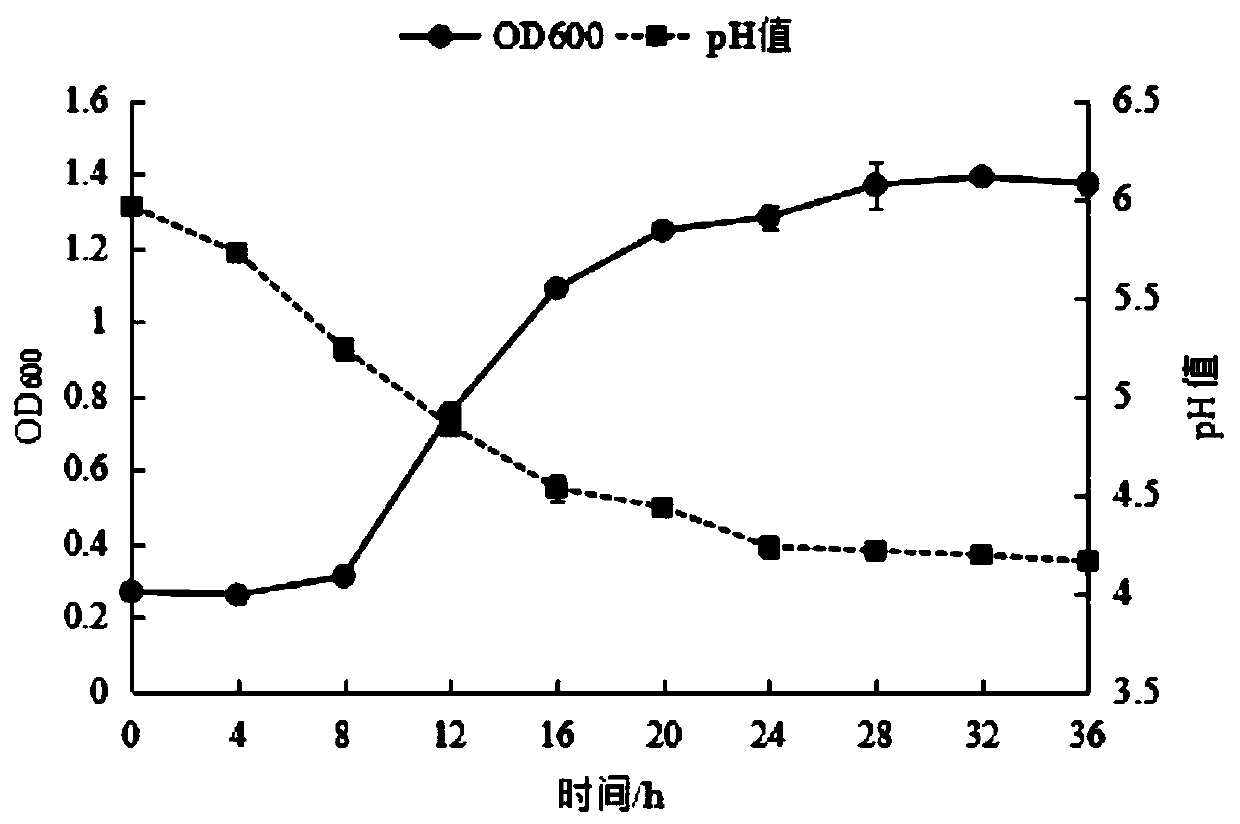Bacillus coagulans L-H7 and application thereof
A technology of Bacillus coagulans and L-H7, which is applied in the direction of bacteria, microorganisms, biochemical equipment and methods, etc., can solve the irreparable problems of low-salt flavor and nutritional value, and achieve better sensory quality, strong acid production ability, The effect of lowering the pH
- Summary
- Abstract
- Description
- Claims
- Application Information
AI Technical Summary
Problems solved by technology
Method used
Image
Examples
Embodiment 1
[0047] The preliminary screening of embodiment 1 bacillus coagulans
[0048] Take 10g of the sample and dissolve it in 90ml of sterile PBS, shake it well, put it into the modified MRS medium (add 10g of α-methylglucoside and 1g of potassium sorbate on the basis of 1L MRS medium), at 45°C , 200r / min enrichment culture for 48h. After the enriched bacterial solution was bathed in water at 80°C for 10 minutes, it was serially diluted and poured into a solution containing 0.3% CaCO 3 In the MRS solid plate of MRS, culture at 37°C. After the colony grows, select a single colony that produces a calcium-dissolving circle, and repeatedly streak to separate and purify to obtain a pure colony. Gram staining was performed on the pure bacteria, and 39 Gram-positive rod-shaped bacteria were selected as candidate strains. After separation and purification, physiological and biochemical identification was carried out, and 14 strains were screened positive for contact enzymes. Fermenting gluc...
Embodiment 2
[0049] The double screening of embodiment 2 bacillus coagulans
[0050] The acid-producing ability, salt resistance, nitrite resistance, and the inhibition of food-borne pathogenic bacteria Listeria monocytogenes, Escherichia coli, Staphylococcus aureus, and Bacillus cereus of the strains obtained by testing bacteria characteristics. The antibacterial experiment adopts the Oxford cup agar diffusion method. Add an appropriate amount of 1.5% plain agar to the sterile plate in advance, and put it into the Oxford cup after solidification. Add 15 mL of semi-solid medium (containing 0.6% agar) to 10 μL of viable bacteria 8 CFU / mL indicator bacteria (Listeria monocytogenes, Escherichia coli, Staphylococcus aureus, Bacillus cereus), poured into the plate containing agar, after solidification, take out the Oxford cup, add 200μL of bacterial fermentation to each well The supernatant and the blank MRS medium were used as controls, and the antibacterial effect was observed after culturi...
Embodiment 3
[0054] The identification of embodiment 3 bacillus coagulans
[0055] The screened strain L-H7 was identified by 16S rDNA molecular biology, and compared with the 16S rDNA sequences of known species in Genbank by Blast, it was found that the strain L-H7 was homologous to Bacillus coagulans HM-08 and Bacillus coagulans LBSC The sex reached more than 99%, and it was determined to be Bacillus coagulans. The 16SrDNA sequence of the strain is shown in SEQ ID NO:1.
[0056] The morphology of the strain L-H7 is as follows: the surface of the colony is smooth, opaque, with regular edges and a raised center. Observing the shape of bacteria cells with oil immersion microscope, the strains are Gram-positive bacteria, long rod-shaped, arranged in pairs or chains.
PUM
 Login to View More
Login to View More Abstract
Description
Claims
Application Information
 Login to View More
Login to View More - R&D
- Intellectual Property
- Life Sciences
- Materials
- Tech Scout
- Unparalleled Data Quality
- Higher Quality Content
- 60% Fewer Hallucinations
Browse by: Latest US Patents, China's latest patents, Technical Efficacy Thesaurus, Application Domain, Technology Topic, Popular Technical Reports.
© 2025 PatSnap. All rights reserved.Legal|Privacy policy|Modern Slavery Act Transparency Statement|Sitemap|About US| Contact US: help@patsnap.com



